#roman gaul
Explore tagged Tumblr posts
Text
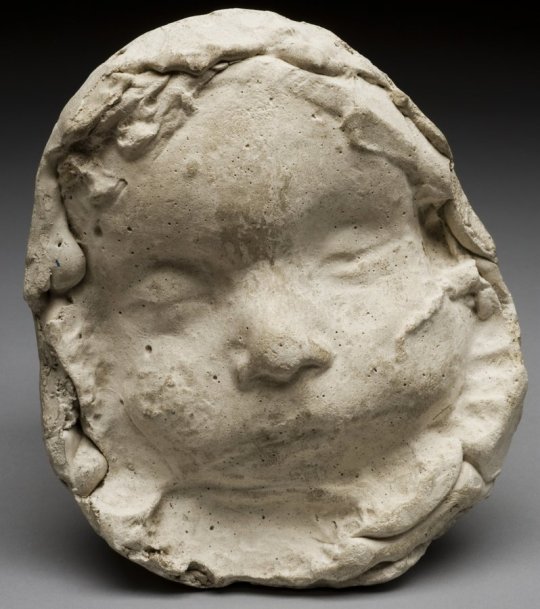
Plaster cast of the face of an infant who was buried in Lutenia (modern-day Paris) around 200 CE. The mask was probably created accidentally when cement leaked into the sarcophagus.
165 notes
·
View notes
Text

pspspspsp I'm working on a lil' project that unfortunately has been shelved due to longfic work, novel prep, work in general, and the fact that I'm a parent who just got elected to a museum board!
The Bad Batch/Clone Wars....ROMAN EMPIRE AU!
Clone Force 99 (Nonaginta Novem) the auxiliary legion who assists in the rescue of soldier/scholar Resonare (Latin for 'Echo') from deep within enemy lines in Germania. Captain Rex fits in, too.
Man, Rex was MADE for a Roman AU but I digress.
The auxiliary is composed of foreign soldiers who Don't Quite Fit In with the rest of the troops due to their unorthodox methods.
We got a hunter from Mauretania (Hunter), a demolitions expert and builder from Aegyptus (Wrecker), an assassin/sicarii from Judaea (Crosshair), and, of course, a druid/warrior scholar from the Veneti tribe in Gaul.
Yup, that's Tech. And figuring out what to do about his goggles was interesting. But there's always face tattoos.
(I threw in my OC as a Celtic lady from Hibernia because I Freaking Could)
I love studying ancient Gaul and Britain. I blame watching this (kind of terrifying but educational) video while on spring break as a kid:
youtube
At some point (8:19) it gets to an animated story with a guy in black robes wearing a deer skull talking about revenge, so, yeah. 'Educational but terrifying' was the average day for us in the 90's.
Anywho, I'm digressing beyond digressing on this fine OC Sunday. Enjoy!
@eyecandyeoz @deezlees @thecoffeelorian @sued134 @techs-stitches @autistic-artistech and all my other OC makers!
#tbb#the bad batch#cloneforce99#thebadbatch#fanfiction#star wars#star wars au#roman empire#tbb tech#tech au#druid au#ancient rome#roman history#roman art#ancient history#roman gaul#clone trooper tech#tech x oc#oc x cc#oc x canon#tech clone trooper#the bad batch au#the bad batch oc#oc sunday#oc art#original character#my art
16 notes
·
View notes
Text
Great find.
2 notes
·
View notes
Text
Diodorus Siculus spent much of his life describing major historical events such as the fall of Troy or the rise of Alexander the Great. But, sometime in the middle of the first century BC, the Sicilian-born Greek writer felt moved to address a contemporary issue that had captured his attention: the drinking habits of the Gauls, the Celtic people who occupied modern-day France at this time.
The Gauls were, he observed, excessively fond of wine, so much so that they usually drank it neat and often went into battle inebriated. In Siculus’s eyes, this love of the grape not only betrayed the Gauls’ lack of breeding (a civilised Roman would always dilute his wine), it also left them open to exploitation by canny Roman traders.
“Many Italian merchants, with their usual passion for money, look on the Gallic craving for wine as their treasure,” he wrote. “They transport the wine by boat on the navigable rivers and by wagon through the plains, and receive in return for it an incredibly high price.” Then, with thinly veiled incredulity, Siculus added: “For an amphora [a wheel-thrown terracotta container that typically held around 20 litres of liquid] of wine they get in return a slave – a servant in exchange for a drink!”
It will come as a shock to absolutely no one to learn that human beings were every bit as likely to succumb to the temptations of drink 2,000 years ago as they are today. What many people will find more surprising about Siculus’s words, however, is the picture they paint of relations between the Romans and their Celtic neighbours – one in which the two peoples were engaging in trade, rather than hacking each other to pieces.
In the popular imagination, the Celtic-speaking people of western Europe were constantly at war with the Romans. The truth was very different. There were battles, of course, and the relationship would eventually end in bloodshed and subjugation after Julius Caesar launched his campaigns of conquest in Gaul in 58 BC. But the violence was preceded by long periods of peace and collaboration, and that collaboration benefited both parties.
Siculus clearly thought that the Gauls were being duped by wily Roman traders. After all, in Rome a Gaulish slave would fetch five or six times the price they could command at home. But Siculus was missing the point. In Gaul, slaves were available in surplus, a result of raiding between rival tribes. Once an external market developed for slaves, raiding could be intensified to satisfy the demand. A Gaulish leader could then offload surplus slaves in return for Roman wine that, distributed to his followers, would greatly enhance his status. For the chief, then, it was a very good deal indeed.
The Roman merchants were also doing very nicely out of their trading links with the Gauls. By the late second century BC, the Roman economy was changing dramatically. Small farms were being bought up and merged into vast estates run for their aristocratic owners by managers commanding armies of slave workers. The easiest commodity to produce on the slave-manned farms was wine. But as the estates grew and became more reliant on grape monoculture, wine production began to outstrip Italian demand. For the estates in western Italy, the solution to the problem was simply to ship the surplus to the major ports of southern Gaul – Massalia (Marseilles) and Narbo (Narbonne) – where middlemen were ready to transport it to the Gauls. The slaves acquired in return were brought back to labour on the estates. It was a system that benefited everyone – except, of course, the slaves.
— The Celts: were they friends or foes of the Romans?
#barry cunliffe#the celts: were they friends or foes of the romans#history#classics#economics#trade#commerce#food and drink#alcohol#slavery#ancient greece#ancient rome#gaul#roman gaul#celts#diodorus siculus#julius caesar
4 notes
·
View notes
Text
Awesome 🔥
#french history#history of france#history blog#france#up the baguette#gaulish history#Gaulish language#linguistics#gaulois#archeology#archeologie#Gallo-roman#Gaule romain#roman empire#Roman gaul#Curse tablets
1 note
·
View note
Photo
Gallic Wars, (58–50 bce), campaigns in which the Roman proconsul Julius Caesar conquered Gaul. Clad in the bloodred cloak he usually wore “as his distinguishing mark of battle,” Caesar led his troops to victories throughout the province, his major triumph being the defeat of the Gallic army led by the chieftain Vercingetorix, in 52 bce. Caesar described these campaigns in De Bello Gallico (“On the Gallic War”).


A coin from Narbonne that was the first Roman colony in Gaul, c. 118 BCE.
Obverse: Goddess Roma with a Gallic helmet
Reverse: Naked Gaul warrior holding a speer, a shield and a horn is driving a biga
https://smb.museum-digital.de/index.php?t=objekt&oges=144845
Source: Münzkabinett, Staatliche Museen zu Berlin - Stiftung Preußischer Kulturbesitz.CreatoR: Lutz-Jürgen Lübke (Lübke und Wiedemann) Copyright Notice: CC BY-NC-SA
#studyblr#history#classics#military history#numismatics#coins#gallic wars#battle of gergovia#ancient rome#roman republic#gaul#roman gaul#narbonne#julius caesar#vercingetorix#roma#commentarii de bello gallico
258 notes
·
View notes
Text

The Sacred Grove of the Druids, set design from Vincenzo Bellini's Opera ''Norma''
#vincenzo bellini#norma#opera#druids#druid#sacred grove#sacred groves#high priestess#woods#forest#art#gaul#gallic#ancient gaul#gauls#pagan#paganism#europe#european#ritual#rituals#ceremony#tradegy#oroveso#chief#antiquity#religion#roman#ancient rome#villeneuve
2K notes
·
View notes
Text

court freak
#avowed#pillars of eternity#avowed spoilers#the envoy#envoy of aedyr#envoy esyllt#my art#went for a roman occupied gaul vibe because. idk roman fashion seems to be the aedyr Look#in the most General way possible. im not an expert on that era
134 notes
·
View notes
Text
(x)
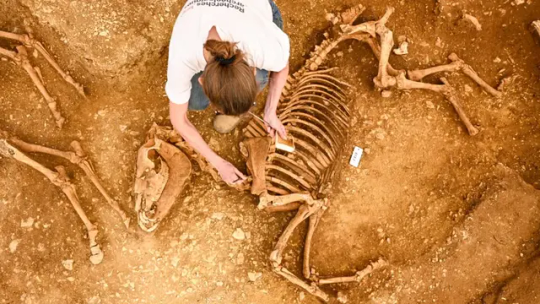

Archaeologists Uncover ‘Astonishing’ Remains of Horses Buried 2,000-Years-Ago
Archaeologists in France have uncovered nine “astonishing” graves containing the skeletons of 28 horses that were buried about 2,000 years ago, though their precise cause of death remains a mystery.
Discovered in Villedieu-sur-Indre, a commune in central France, two of the graves have been fully excavated so far, the French National Institute for Preventive Archaeological Research (INRAP) said in a statement.
The horses have been radiocarbon-dated back to somewhere between 100 BC to 100 AD.
Archaeologists found 10 complete horse skeletons in one pit and two in the other, all carefully placed in the same manner lying on their right flank with their heads to the south.
All these horses were buried at the same time shortly after their deaths, archaeologists said after observing the position of the skeletons and the connections between the bones.
Another grave is situated between these two pits but it contains two medium-sized dogs, both lying on their left side with their heads facing west.


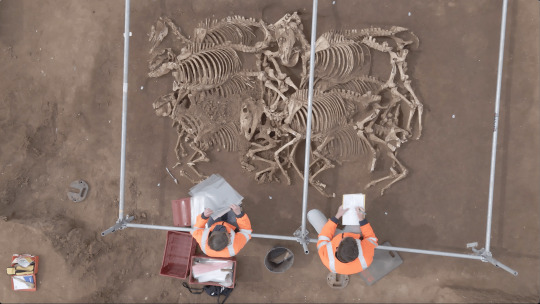
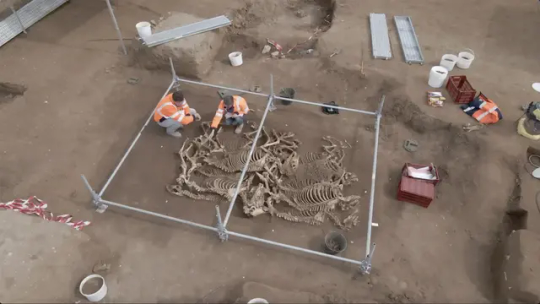
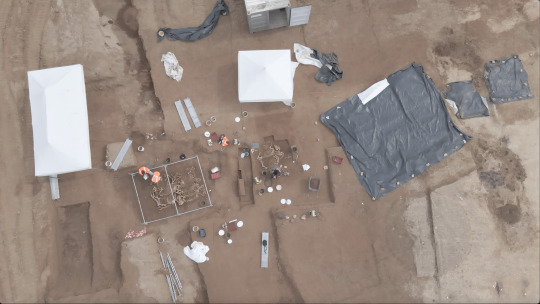
Archaeologists have yet to fully excavate the remaining graves but have already identified a total of 28 horses from the skulls and coxal bones that appear on the surface.
Killed in battle, or ritual sacrifice?
However, the horses’ precise cause of death still remains unclear.
Archaeologists have ruled out an epidemic since there are no foals or mares in these graves; all the skeletons are fully-grown stallions aged over four years old. That leaves, archaeologists said, the possibilities that these horses were either killed in battle or as part of a ritual sacrifice.
When these horses died about 2,000 years ago, there was a fortified Celtic settlement known as an oppidum just a few hundred meters away and this location mirrors that of two other similar horse burial sites that archaeologists had previously uncovered in the same region.
Due to this location, they have hypothesized that the horses’ deaths at the sites could be connected to the battles of the Gallic Wars in which Julius Caesar conquered Gaul between 58 - 50 BC.
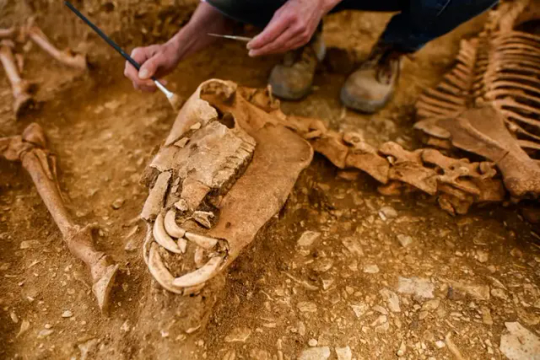

There may be another explanation, however: ritual sacrifice.
“The hypothesis that these animals were sacrificed as part of a complex ritual, of which only a few scraps remain, must also be considered,” the INRAP statement said.
If these horses were indeed buried as part of a ritual rather than killed in battle, the sheer number shows the “importance and extent of the sacrifice,” the statement added.
Other finds at the site, which sits on the slope of a valley, include buildings, pits, ditches and a road that archaeologists dated to the late 5th and early 6th centuries.
By Issy Ronald.
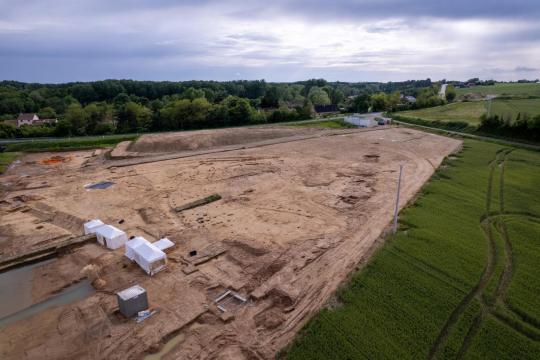
#history#classics#military history#archaeology#animals#burials#gallic wars#ancient rome#celts#gaul#roman gaul#france#horses
1K notes
·
View notes
Text

Dying Gaul, a statue likely made in Roman times, commemorating a Greek Battle Victory over Gauls
#dark academia#light academia#classical#academia aesthetic#escapism#academia#books and libraries#classic literature#books#architecture#statue#sculpture#dying gaul#roman#greek#gauls#royal core#cottage vore#museum#aesthetic#academics#artistic#aesthetics#mood#vibe#tumblr
102 notes
·
View notes
Text
Go get a room-


Had to do this
They really got to my heart
Maybe they also got each other's heart-??
Anglaigus seems not amused about our fellow legionary's comment :D
#asterix fanart#asterix art#asterix the gaul#asterix and obelix#asterix#asterix roman fanart#bludary#astérix et obélix#astérix#artists on tumblr#fanart#bludary art
69 notes
·
View notes
Note
penny for ur thoughts.. black brothers
i actually think this is one of those rare situations where the conspicuous lack of incest is actually more compelling than their ship (to me)… i don’t want them to ever do anything with each other but i want them to feel the others absence in everything else. you know.
+ i’ve been moving away from weepy/sensitive/softboy conceptions of regulus in general.. i want him tall and severe and a little plain-looking, with pale skin and a brutalist overcast to his face.
like im getting really into configuring regulus’s primary trait as like… endurance. sirius has this too, but sirius is defined by the fact that he’s maintained his goodness in spite of everything. regulus is scorched earth by comparison. he is just, like, constantly wearing the expression of an 1870s child laborer who has been forced into the coal mines. just so bleak. but he’s sirius’s brother so he’s STUBBORN and holding on by his damn fingernails. for nothing but spite alone!! spite for his family & his brother & the entire world.
i think i enjoy my regulus best when he has never once cried over sirius. he is very plain and unremarkable but he is not blubbering for anything. it give him a certain sense of stoic dignity that is both attractive & unique.
#a#teenage boy who has the bearing of like . a tortured roman legionnaire sleeping in a muddy hole to ambush the gauls#saints speaks 🐇
65 notes
·
View notes
Text
It’s difficult to estimate with any precision the volume of trade flowing between Rome and Gaul. But the number of shipwrecks found off the Gaulish coast surges after 150 BC, peaking at about 100 BC. This suggests an exponential rise in the volume of trade over that half century.
For the most part, the vessels’ cargos were dominated by wine. The Madrague de Giens wreck was carrying around 7,000 amphorae when it sank off Hyères (south-eastern France) in about 50 BC. The quantity of amphorae discovered on the wreck suggests that the annual export of wine to the Gauls had reached about 100,000 hectolitres a year by the first century BC – a volume that would have generated about 40 million amphorae over the century. It is hardly surprising, then, that the Roman stereotype of a Gallic man was of a drunkard slurping wine through his long, drooping moustache.
The wine was transported along two major trade routes. One started at Narbo (modern-day Narbonne, founded in 118 BC), snaked along the river Aude and then overland to Tolosa (Toulouse) on the Garonne. The other travelled up the Rhône to Cabillonum (Chalon-sur-Saône) in the territory of the Aedui.
From these major transhipment centres, the wine was then taken into Gaulish territory to the principal settlements within easy reach of the frontier – places such as Bibracte, Jœuvres, Essalois and Montmerlhe. Roman traders may well have been resident in these native centres to oversee the exchanges. There were certainly Italian merchants in Cabillonum as late as 52 BC. These men were charged with ensuring a steady flow of slaves to markets in a bid to meet the Roman estates’ demand for a staggering 15,000 Gaulish slaves every year.
— The Celts: were they friends or foes of the Romans?
#barry cunliffe#the celts: were they friends or foes of the romans#history#classics#economics#trade#commerce#transport#maritime history#food and drink#alcohol#archaeology#slavery#ancient rome#gaul#roman gaul#celts
11 notes
·
View notes
Text
Sources for Celtic History and Paganism!
So today I was reading Ancient Fire: An Introduction to Gaulish Celtic Polytheism by Segomâros Widugeni when it struck me just how many of the sources were the type of thing that wouldn't necessarily come up on a regular search, particularly some out-of-print books, a lot of which are actually available on the Internet Archive! I took some time to take note of each listed source, and tried to see if I could find the right place to request them from (in the case of a handful of articles and theses), find PDF links where they did already exist, basically whatever I could! Some books are available to buy, most secondhand, and while most are available on Amazon, I won't be linking those here. I'd encourage anyone shopping to consider an alternative option if they can! Now, I haven't read through all of these, but the moment I found at least one of them seems to be impossible to find, I was reminded of the dangers of dying media. So I wanted to put these together so anyone could use them. Not every resource listed is in English. Anyway, on to the list~
Cernunnos: Looking a Different Way
By Ceisiwr Serith
https://ceisiwrserith.com/therest/Cernunnos/cernunnospaper.htm
Cernunnos Origin and Transformation of A Celtic Divinity
By Phyllis Fray Bober
https://www.scribd.com/document/460345187/cernunnos-origin-and-transformation-of-a-celtic-divinity-phyllis-fray-bober
Basic Celtic Deity Types
by Alexei Kondratiev
https://naomh-na-tursan.livejournal.com/5752.html
Deep Ancestors: Practicing the Religion of the Proto-Indo-Europeans
Book by Ceisiwr Serith
https://www.scribd.com/document/362472999/Deep-Ancestors-Practicing-the-Religion-of-the-Proto-Indo-Europeans
The Gods of the Celts and the Indo-Europeans
Book by Garrett S. Olmsted
https://www.academia.edu/38135817/The_Gods_of_the_Celts_and_the_Indo_Europeans_revised_2019_
Dictionary of Celtic Myth and Legend
Book by Miranda Aldhouse-Green
https://www.thriftbooks.com/w/dictionary-of-celtic-myth-and-legend_miranda-aldhouse-green/543335/#edition=5215209&idiq=16154030
The Book of The Great Queen: The Many Faces of the Morrigan from Ancient Legends to Modern Devotions
Book by Morpheus Ravenna Further
to tongu do dia toinges mo thuath [“Mi a dyngaf dynged it”], &c.
By John Koch
https://www.academia.edu/7242277/Further_to_tongu_do_dia_toinges_mo_thuath_Mi_a_dyngaf_dynged_it_and_c
Goddesses in Celtic Religion Cult and Mythology: A Comparative Study of Ancient Ireland, Britain and Gaul
By Noémie Beck
http://theses.univ-lyon2.fr/documents/lyon2/2009/beck_n#p=0&a=title
The Integration of Mercury and Lugus: Myth and History in Late Iron Age and Early Roman Gaul
By Krista Ovist
https://archives.library.wales/index.php/integration-of-mercury-and-lugus
Lady with a Mead Cup: Ritual, Prophecy, and Lordship in the European Warband from La Tène to the Viking Age
Book by Michael J. Enright
How to Kill a Dragon: Aspects of Indo-European Poetics
Book by Calvert Watkins
https://ia801404.us.archive.org/view_archive.php?archive=/7/items/twain-mark-a-connecticut-yankee-in-king-arthurs-court/1-ptry.zip&file=How%20to%20Kill%20a%20Dragon%20-%20Aspects%20of%20Indo%20European%20Poetics.pdf
The Celtic Gauls: Gods, Rites and Sanctuaries
Book by Jean-Louis Brunaux
The Apple Branch: A Path to Celtic Ritual
Book by Alexei Kondratiev
https://archive.org/details/applebranchpatht0000kond
Oxford Dictionary of Celtic Mythology
Book by James Mackillop
https://archive.org/details/dictionaryofcelt0000mack
The female deities of the Celtic religion: worship and mythology: a comparative study of ancient Ireland, Great Britain and Gaul
By Noémie Beck
https://theses.fr/2009LYO20084
Celtic Curses
Book by Bernard Mees
https://www.academia.edu/1012094/Celtic_Curses_Woodbridge_Boydell_2009
Guide to Irish Mythology
Book by Daragh Smyth
https://archive.org/details/guidetoirishmyth00smyt
The Sacred Isle
Book by Dáithí Ó hÓgáin
https://archive.org/details/sacredislebelief0000ohog
The Matronae and Matres: Breathing New Life into an Old Religion
By River Devora
http://polytheist.com/the-web-of-blessings/2015/08/12/the-matronae-and-matres-breathing-new-life-into-an-old-religion/
Interpretatio Romana and Matronae Iconography
By River Devora
http://polytheist.com/the-web-of-blessings/2015/08/31/interpretatio-romana-and-matronae-iconography/#:~:text=The%20overlay%20of%20interpretatio%20Romana,and%20plaques%20and%20glean%20valuable
Celtic chiefdom, Celtic state: the evolution of complex social systems in prehistoric Europe
By Arnold, Bettina and Gibson, D. Blair
https://searchworks.stanford.edu/view/3086499
*butacos, *wossos, *geistlos, *ambactos. Celtic Socioeconomic Organisation in the European Iron Age. Studia Celtica 40, 2006: 23-41
By Raimund Karl
https://www.academia.edu/245239/_butacos_wossos_geistlos_ambactos_Celtic_Socioeconomic_Organisation_in_the_European_Iron_Age_Studia_Celtica_40_2006_23_41
The Ancient Celts
Book by Barry Cunliffe
https://archive.org/details/ancientcelts00cunl_0
Sengoidelc: Old Irish for Beginners
Book by David Stifter
https://archive.org/details/sengoidelcoldiri0000stif
Greek Kελτóς and Γαλάτης, Latin Gallus ‘Gaul’
By Kim McCone
https://spr.harrassowitz-library.com/article/spr/2006/1/6
Celtic Heritage: Ancient Tradition in Ireland and Wales
Book by Alwyn and Brinley Rees
https://archive.org/details/in.gov.ignca.36494
Celtic Reconstructionist Paganism
By Erynn Rowan Laurie, Kathryn Price NicDhàna, Aedh Rua Ó Mórríghan, Kym Lambert ní Dhoireann and John Machate, ed. by Erynn Rowan Laurie
https://web.archive.org/web/20080418025755/http://www.witchvox.com/va/dt_va.html?a=usma&c=trads&id=6645
Which witch is which? : a concise guide to Wiccan and Neo-Pagan paths and traditions
Book Compiled and Edited by Patricia Telesco
Sources for the Three Realms
By Annie Loughlin - original source link is dead, need help to locate!
Dictionnaire de la Langue Gauloise
Book by Xavier Delmarre
https://archive.org/details/dictionnairedelal00dela (referred to as “Essential for Gaulish Language study)
The Settling of the Manor of Tara
By R.I. Best
https://www.ucd.ie/tlh/trans/rib.eriu.4.001.t.text.html
The court of law in Iron Age ‚Celtic’ societies. In R. Karl & J. Leskovar (eds.), Interpretierte Eisenzeiten 3. Fallstudien, Methoden, Theorie. Tagungsbeiträge der 3. Linzer Gespräche zur interpretativen Eisenzeitarchäologie. Studien zur Kulturgeschichte von Oberösterreich Folge 22, Linz: Oberösterreichisches Landesmuseum 2009: 135-60.
By Raimund Karl
https://www.academia.edu/245221/The_court_of_law_in_Iron_Age_Celtic_societies_In_R_Karl_and_J_Leskovar_eds_Interpretierte_Eisenzeiten_3_Fallstudien_Methoden_Theorie_Tagungsbeitr%C3%A4ge_der_3_Linzer_Gespr%C3%A4che_zur_interpretativen_Eisenzeitarch%C3%A4ologie_Studien_zur_Kulturgeschichte_von_Ober%C3%B6sterreich_Folge_22_Linz_Ober%C3%B6sterreichisches_Landesmuseum_2009_135_60
Matasović Etymological Dictionary Of Proto Celtic
By Ranko Matasović
https://archive.org/details/matasovic-etymological-dictionary-of-proto-celtic
Hammer of the Gods: Anglo-Saxon Paganism in Modern Times Second Edition
Book by Swain Wodening
https://archive.org/details/hammerofgodsangl0000swai
Various Works by Christopher Scott Thompson - recommended re: honor in Gaulish society
https://cateransociety.wordpress.com/books/
A Handbook of the Scottish Gaelic World
Book by Michael Newton and Michael Steven Newton
Celtic Values
By Alexei Kondratiev
http://dagdacelt.freehostia.com/values.html
European paganism : the realities of cult from antiquity to the Middle Ages
By Ken Dowden
https://archive.org/details/europeanpaganism0000dowd
A Definitive Reconstructed Text of the Coligny Calendar
By Garrett Olmsted
https://www.academia.edu/62011364/A_Definitive_Reconstructed_Text_of_the_Coligny_Calendar
New Calendar of Gaulish Polytheism
By Jess via Nemeton Nigromanitcos
https://thebloodybones.wordpress.com/2015/07/10/new-calendar-of-gaulish-polytheism/#more-265
Calendar of Feast-Days of Deities
Via the blog Deo Mercutio
https://deomercurio.wordpress.com/calendar-of-feast-days-of-deities/
Altkeltische Sozialstrukturen
By Raimund Karl
https://homepage.univie.ac.at/Raimund.Karl/Sozialstrukturen.pdf
La Langue Gauloise
Book by Pierre-Yves Lambert
https://www.scribd.com/document/782869557/Lambert-1994-La-langue-gauloise-description-linguistique-commentaire-d-inscriptions-choisies
Death, War, and Sacrifice: Studies in Ideology & Practice
Book by Bruce Lincoln
The Gods of the Celts
Book by Miranda Aldhouse-Green
https://archive.org/details/godsofceltsar00mira
War Goddess The Morrigan And Her Germano Celtic Counterparts
Book by Angelique Gulermovich Epstein
https://archive.org/details/WarGoddessTheMorriganAndHerGermanoCelticCounterparts
Epigraphik-Datenbank Clauss/Slaby
- Database of “almost all inscriptions ever recorded”
https://db.edcs.eu/epigr/hinweise/hinweis-en.html
A website on Gallo-Roman religion:
http://www.deomercurio.be/en/
A scholarly website with information on Epona:
https://epona.net/
#witch#witchcraft#magic#witchblr#witchy#pagan#paganism#resources#pagan resources#celtic#celtic pagan#roman pagan#gaulish#gaulish paganism#gaulish polytheism#advwitchblr#continental celtic#Cernunnos#Kernunnos#the morrigan#celtic paganism#polytheism#Gaul#Irish paganism
43 notes
·
View notes
Text
Still more important is the realization that all those generations of British people (largely men), who were educated in the classics, were being taught to understand and sympathize with the Greeks and Romans. When thinking of the long confrontation between the Celts and Romans, therefore they instinctively sided with the Romans. They would have all read Tacitus' warning: "Remember, they are barbarians..." For the Romans were seen as the bearers of civilization and the ancient Britons as the uncivilized.....
All manner of pressure was brought to bear to ensure that British schoolboys empathized with Rome. From the sixteenth century to the mid-twentieth, every educated person was required to learn Latin. Caesar and Tacitus were among the very first authors which all those pupils were obliged to read. Yet no one taught them anything about the Celts, let alone a Celtic language. Even today, when the teaching of classics in the United Kingdom has sharply declined and Celtic studies receive a measure of official support, for every British schoolchild that learns even a little about the native Celtic heritage, there are a hundred that still learn about the heritage of Rome.
A whole literary genre was devoted to strengthening the bond of identity between the modern Britons and the Ancient Romans. Any number of books and poems have been written to invite the reader to stand in Roman shoes, to put oneself shoulder to shoulder with the legions in the eternal struggle of civilization against barbarity.
-Norman Davies, The Isles
#So this book presents an interesting view of modern England that claims that Englands obsession with colonization imperialism and conquest#is directly descended from Britains own colonization by Rome#The modern Englishman according to Davies knows more about Greece and Rome than the pre Roman history of his own land#Even modern English people believe that the Celts Picts and Gauls (their own ancestors) were savage barbarians#whose conquest by the more “civilized” Romans was NECESSARY to make the isles civilized.#cycle of violence etc#colonization#colonialism#roman history#british history#celtic tag#imperialism
122 notes
·
View notes
Text

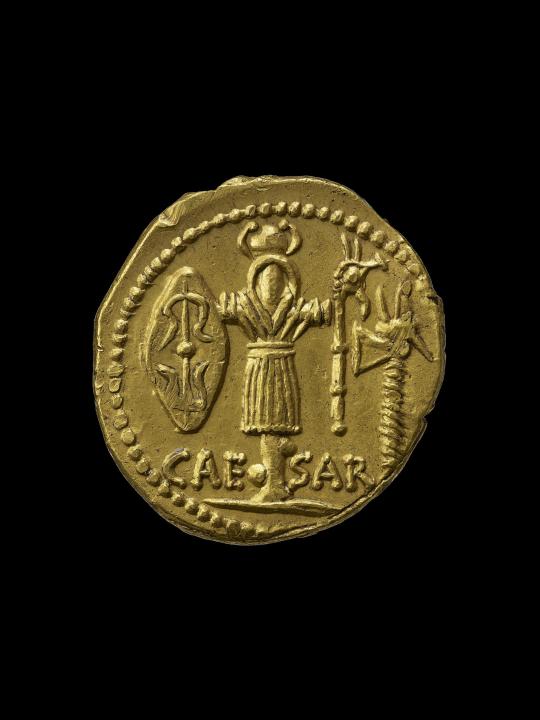
Aureus with female head wearing oak wreath (obverse) and trophy with Gallic shield and carnyx (reverse), minted under Julius Caesar
Roman, Republican Period, after July 13, 48 B.C.
gold
British Museum
#Ides of March#Julius Caesar#Caesar#coin#numismatics#Gallic Wars#Gaul#carnyx#trophy#Roman Republic#Ancien Rome#Roman#gold#British Museum
96 notes
·
View notes